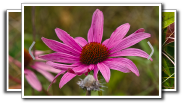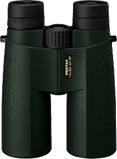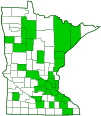Dog sick slime mold
(Didymium spongiosum)
Conservation • Description • Habitat • Ecology • Distribution • Taxonomy
Conservation Status |
|||
| IUCN Red List | not listed |
||
| NatureServe | not listed |
||
| Minnesota | not listed |
||
Description
Dog sick slime mold is a widespread and very common slime mold. It occurs in Europe, Asia, North America, Australia, and New Zealand. It occurs throughout the United States, but it is most common east of the Great Plains and west of the Rocky Mountains.
Dog sick slime mold is found from May to October, in areas with rich soil and abundant organic matter, often seeking out rotting wood, leaf litter, and wood chip mulch where it feeds on bacteria and fungi. It is frequently seen as it migrates off the substrate and crawls up the stems of living plants or onto wet grass to position its fruiting body for spore dispersal.
When it first appears, it is yellow and it looks like a multitude of numerous growths. In fact, it is a single massive fruiting body known as an aethalium. This is the plasmodium, the foamy or slimy feeding stage. Within 24 hours, the aethalium dries out and its color fades, leaving a pale, brittle crust, or cortex, that resembles a dry, white patch of old leather. This crust is heavily impregnated with calcium carbonate (lime) crystals, which gives the structure its chalky or spongy texture and bright white appearance.
The fragile cortex soon flakes away, revealing the powdery, usually purplish brown or dark gray spore mass within. The spores are dispersed by wind and rain.
Similar Species
Habitat and Hosts
Areas with rich soil and abundant organic matter
Ecology
Season
May to October
Distribution |
||
|
Sources Biodiversity occurrence data published by: Minnesota Biodiversity Atlas (accessed through the Minnesota Biodiversity Atlas Portal, bellatlas.umn.edu, 111/5/2025). |
|
| 11/5/2025 | ||
Occurrence |
||
Very common |
||
Taxonomy
Kingdom
Fungi (fungi)
Phylum
Mycetozoa (slime molds)
Class
Myxomycetes (true slime molds)
Subclass
Columellomycetidae
Superorder
Stemonitidia
Order
Physarales
Family
Didymiaceae
Genus
Didymium
Higher ranking
There is ongoing disagreement about the classification of slime molds above the rank of genus. The ranking above follows Global Biodiversity Information Facility (GBIF), MycoBank, MycoPortal, Catalogue of Life (COL), and iNaturalist. It is not in agreement with Index Fungorum or ITIS, neither of which agree with GBIF or even with each other.
Genus
Until very recently, this species was known as Mucilago crustacea. Several molecular studies from 2008 to 2023 have shown that Mucilago crustacea “is deeply nested in Didymium.” This has been debated by authors who argued that species with such extreme morphological differences could not possibly belong to the same genus. A recent phylogenetic study (García-Martín, J.M. et al. 2023) moved Mucilago crustacea to the genus Didymium.
Subordinate Taxa
Synonyms
Diderma spumariaeforme
Diderma spumariiforme
Mucilago crustacea
Mucilago crustacea var. dictyospora
Mucilago crustacea var. solida
Mucilago dictyospora
Mucilago solida
Mucilago spongiosa
Mucilago spongiosa var. dictyospora
Mucilago spongiosa var. solida
Mucor spongiosus
Reticularia alba
Spumaria alba
Spumaria alba var. cornuta
Spumaria alba var. dictyospora
Spumaria alba var. laminosa
Spumaria alba var. mucilago
Spumaria alba var. solida
Spumaria cornuta
Spumaria mucilago
Spumaria solida
Common Names
dog sick slime mold
dog vomit slime mold
Glossary
Aethalium
The large, pillow-like, fruiting body with an outer crust of some slime molds, formed by the fusion of many plasmodia into a single functional mass. Plural: aethalia.
Plasmodum
A single-celled organism consisting of a mass of protoplasm without cell walls (naked) and with thousands of nuclei.
Visitor Photos
Share your photo of this slime mold.
This button not working for you?
Simply email us at info@MinnesotaSeasons.com.
Attach one or more photos and, if you like, a caption.
Dan W. Andree |
||
Came across this strange whitish stuff... There were several of these in an area some larger and some smaller. This one was fairly large maybe 8 inches or more and there were several splattered here and there in the 4-6 inch size. They were dried up and maybe some kind of white slime mold fungi but I have no idea what they could be. They weren't real thick or anything but could be broken apart. I didn't take many photos etc. of it because I wasn't sure if it was natural or not but was only in a certain area. This was the biggest one of the maybe 6-8 seen. |
||
MinnesotaSeasons.com Photos
|

Slideshows
Mucilago crustacea is a form of slime mould, in the monotypic genus Mucilago
Θεόδωρος Φωτιάδης
Mucilago crustacea
Mushrooms Fungi

Visitor Videos
Share your video of this slime mold.
This button not working for you?
Simply email us at info@MinnesotaSeasons.com.
Attach a video, a YouTube link, or a cloud storage link.
Other Videos
Mucilago crustacea aka dog sick slime mould
Onderwegmettamara

Visitor Sightings
Report a sighting of this slime mold.
This button not working for you?
Simply email us at info@MinnesotaSeasons.com.
Be sure to include a location.
Dan W. Andree
August 2025

Location: Norman Co. Mn.
There were several of these in an area some larger and some smaller. This one was fairly large maybe 8 inches or more and there were several splattered here and there in the 4-6 inch size. They were dried up and maybe some kind of white slime mold fungi but I have no idea what they could be. They weren't real thick or anything but could be broken apart. I didn't take many photos etc. of it because I wasn't sure if it was natural or not but was only in a certain area. This was the biggest one of the maybe 6-8 seen.
MinnesotaSeasons.com Sightings |
|


